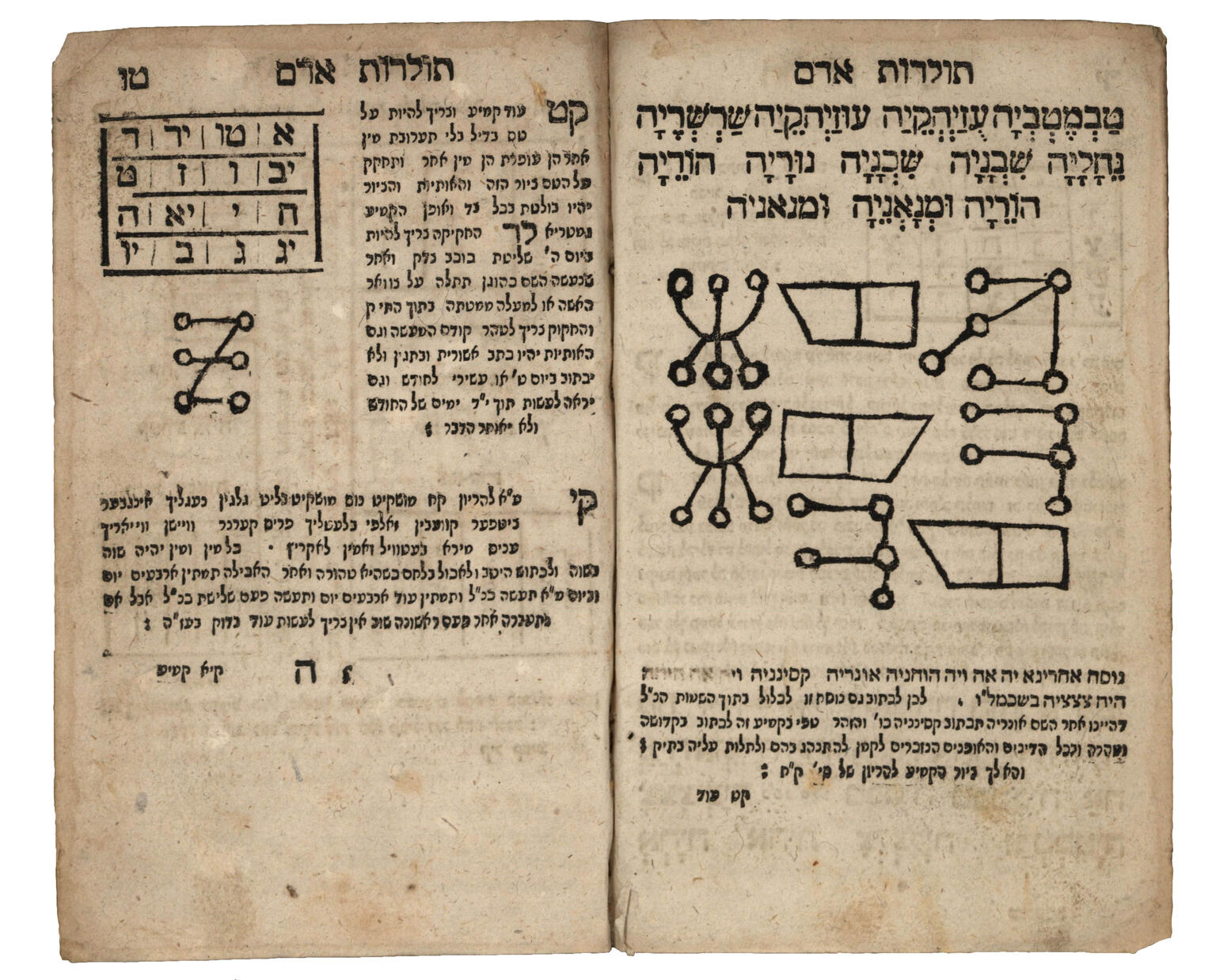Toledot Adam (The Generations of Adam)
Elijah Loanz
1734
Credits
Courtesy GFC Trust / William L. Gross.
Published in: The Posen Library of Jewish Culture and Civilization, vol. 5.
You may also like
Dream Question
!["9. [Image: M9 637 Seder tefilot yesharot u-varot]. Seder Tefilot Yesharot u-barot " Manuscript page of Hebrew text arranged in the shape of a eight-branched candelabrum.](/system/files/styles/entry_card_sm_1x/private/images/vol05/Posen5_blackandwhite165_color.jpg?h=31fc6cc8&itok=ER5JfABc)
Seder tefilot yesharot u-varot (The Order of Upright and Pure Prayers)
![M10 622 Manuscript, probably from Ukraine]. Manuscript probably from Ukraine, c. 1740 with a broad collection of practical kabbalah and mystical magic. Facing page manuscript arranged vertically with Hebrew text in the shape of a figure wielding two long objects.](/system/files/styles/entry_card_sm_1x/private/images/vol05/Posen5_blackandwhite166_color.jpg?h=cec7b3c9&itok=Sz6u21MQ)
Compendium of Practical Kabbalah

Printed Amulet (Germany)

Amulet for a Newborn Boy
![14. [Image: M14 626 An amulet for a newly born female child] Printed page with Hebrew text in the middle surrounded by floral design and figures.](/system/files/styles/entry_card_sm_1x/private/images/vol05/Posen5_blackandwhite169_color.jpg?h=55b496cd&itok=ZMzRFnve)
Amulet for a Newborn Girl
Related Guide
Early Modern Rabbis and Intellectuals on the Move
Carrying books and knowledge, itinerant rabbis and scholars traveled between communities, facilitating cultural exchange.
Related Guide
Early Modern Religious Practices
Early modern Jews both preserved tradition and innovated. Documents and legal texts reveal rich details about synagogue life, marriage, family relations, and death rituals.
Creator Bio
Elijah Loanz
The family of the rabbi and kabbalist Elijah ben Moses Loanz traced its ancestry back to Rashi. Loanz was born in Frankfurt am Main, studied under many prominent rabbis, and himself served as rabbi in Hanua, Fulda, Friedberg, and Worms. In Worms, he was also a ḥazzan (sexton), preacher, and head of the yeshiva. Loanz became a famed kabbalist: his amulets were very popular, and various miracles were attributed to him. He also engaged in disputes with Christian priests and corresponded with the Christian Hebraist Johannes Buxtorf. Loanz composed many works, most of which were not printed in his lifetime and have survived in manuscript form. These include commentaries and supercommentaries on biblical books, commentaries on the Zohar and other kabbalistic works, as well as some secular and liturgical poetry (among them a poetic dispute between wine and water). Examples of his amulets have been preserved in collections reproducing these formulas. Loanz also helped to prepare Moses Isserles’s work Darkhe Moshe (The Ways of Moses) for publication.
You may also like
Dream Question
!["9. [Image: M9 637 Seder tefilot yesharot u-varot]. Seder Tefilot Yesharot u-barot " Manuscript page of Hebrew text arranged in the shape of a eight-branched candelabrum.](/system/files/styles/entry_card_sm_1x/private/images/vol05/Posen5_blackandwhite165_color.jpg?h=31fc6cc8&itok=ER5JfABc)
Seder tefilot yesharot u-varot (The Order of Upright and Pure Prayers)
![M10 622 Manuscript, probably from Ukraine]. Manuscript probably from Ukraine, c. 1740 with a broad collection of practical kabbalah and mystical magic. Facing page manuscript arranged vertically with Hebrew text in the shape of a figure wielding two long objects.](/system/files/styles/entry_card_sm_1x/private/images/vol05/Posen5_blackandwhite166_color.jpg?h=cec7b3c9&itok=Sz6u21MQ)
Compendium of Practical Kabbalah

Printed Amulet (Germany)

Amulet for a Newborn Boy
![14. [Image: M14 626 An amulet for a newly born female child] Printed page with Hebrew text in the middle surrounded by floral design and figures.](/system/files/styles/entry_card_sm_1x/private/images/vol05/Posen5_blackandwhite169_color.jpg?h=55b496cd&itok=ZMzRFnve)



